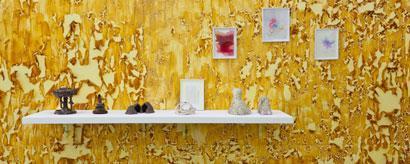These two artists have shared a studio for fifteen years on the Ile Saint-Denis. Invited by Mains d’Oeuvres to develop an exhibition together, they chose to include the artists in the neighboring studios : Florian Bézu, Mimosa Echard, Djamel Kokene, Jonathan Martin, Florence Paradeis, Grégory Petitjean, Frieda Schumann, Maria Tomé. Modeled after their style of work : a collaborative, sensory, and acidic exhibition.

Free guided visit every Sunday at 4 pm.
Visite gratuite pour les groupes : mediation@mainsdoeuvres.org / 01 40 11 25 25
Atelier acidulé 6-12ans , mercredi 20 et samedi 30 juin • 14h ( participation 5€ par enfant)
Dernière nocturne : jeudi 14 juin jusqu’à 22h.
Crash vs Vanity
This exhibition takes its starting point from the profound artistic connection that has existed between Jean-Luc Blanc and Michel Blazy for more than fifteen years. The two artists who live and develop their art on the Ile Saint-Denis wished to invite, for the occasion of this exhibition, the artists in the neighboring studios and, notably, an entire young generation of artists freshly arrived on their island. Une Chainette Relie Toutes Les Pendeloques et Forme Le Corps Principal de l’Objet is an enigmatic proposal. It lets mystery hover, and to break through this mystery there are several paths to take. For Jean-Luc Blanc, the starting point is the crash. He willingly links the exhibition to the story of American actress Jayne Mansfield, to her glamour, her excessive tendency to kitsch, and her tragic end in her Buick Electra in 1967. He also speaks of a genuine collision among the works presented. For Michel Blazy, who diverges from the narrative vision of Jean-Luc Blanc, this exhibition is a grand vanity. We can find within themes of erosion, of time passing or erasure, as in the piece of Mimosas Echard, in the faces of made-up women in Jean-Luc Blanc’s portraits, or in the wall of Michel Blazy. Outside of the geographic aspect that links all these artists together, the question of time and fragility seems to be another kind of commonality, linking the works together outside of their contrasts. This group exhibition, undeniably sensory, a blend of generations of artists who follow each other and exist side by side, becomes a small but vibrant world of its own.
The work of Michel Blazy has, for more than twenty years, explored the relation between the natural and the artificial with humor and derision. He also questions the notions of the consummation of art and consumers of art. He uses perishable materials used in every day life (bread, sweet dreams, dog biscuits, flour, eggs, beetles..) in order to observe and understand the idea of passing time and of disappearance. Born in Monaco in 1966, he lives and works on the Ile Saint Denis. He received his diploma in 1990 from ENSA of the City of Arson. In 2008, he was selected for the Marcel Duchamp Prize, in addition to Laurent Grasso, Stéphane Calais and Didier Marcel. He was exhibited at La Force de l’Art2, at the Grand Palais in 2009.

For fifteen years, he has shared his studio with Jean-Luc Blanc. Jean-Luc Blanc, born in Nice in 1965, lives and works in Paris where he teaches at l’Ecole des Arts Décoratifs (School of Decoartive Arts). He received his diploma in 1989, also at l’ENSA de la Villa Arson. A large retrospective of his work, Opera Rock, took place at the CAPC in Bordeaux in 2009, and included more than two hundred of his paintings and drawings. Painting and drawing are the principal mediums practiced by Jean-Luc Blanc. For une sorte de chaînette reliant les oeuvres-médaillons les unes aux autres au delà de leurs contrastes , he will present new works that resonate with the installations of Michel Blazy.

Jean-Luc Blanc et Michel Blazy have chosen to invite the artists from the neighboring studios. A group exhibition, sensory and acidic, in the image of their work.
Florian Bézu
His approach makes use of the evocation of imaginary places and temporalities in which he draws from archetypes and allgeories present in his work. Utilizing materials that transmute, such as ceramic or wax, his drawings and sculptures undergo a change of state, a formal and conceptual shift. They also acquire an ambiguous status, a new materiality, as if frozen in time, they are transformed into modern relics, in immediate ruins. In this illusion of post-catastrophe, they become fragments of fictions in which the sublime alternates with ridiculous or the ephemeral. A kind of deadly homage, enigmatic display, they revel in strangeness that renounces neither softness nor enchantment.
Mimosa Echard
Born in 1986 in Alès, Mimosa Echard studied at Ensad. She works in drawing and sculpture, utilizing a vocabulary of simple, even archaic, forms (sticks, grottos), but also in emblematic characters (Batman, Humpty Dumpty). She has built up a body of work which functions through series, all in dialogue with one another, with some directing points such as the circle. At once strange and humorous, with a base of natural materials (burnt wood, enamel, ceramic), Mimos Echard’s objects appear to be so many retro-futuristics sign.
Djamel Kokene
At the heart of his work, Djamel Kokene explores the tensions among language, thought, and representation. Always looking to evade the process of identification, he underlines the limits of communication, like that of language. His work, from system to sculpture, put into play the contradictions of our society torn between the necessity of images for communication and comprehension through language and thought. Also, he uses writing in several pieces, at times associated with objects, but also with a strong conceptual anchor. Born in Aïn El Hammam in Algeria in 1968, Djamel Kokene has lived in France since 1978. During his residency at Mains d’Oeuvres from 2002 to 2005, he initiated a collective exhibition, Laplateforme, a mobile laboratory for reflection and research in contemporary artistic protection on the shores of the Mediterranean.
Jonathan Martin
Jonathan Martin was born in 1986 and studied at the London College of Communication and Ensad in Paris. His practice is organized principally around drawing but he also creates animated films, in the tradition of experimental cinema. His works draws inspiration from music, popular culture, and the idea of tradition, expressed by Gershom Sholem as “a kind of treasure hunt” and “a possibility to renew with what as been forgotten or what has not yet been able to manifest”.
Florence Paradeis
The photographs of Florence Paradeis are stops on the image, “selections” of the real. Through her carefully studied staging, the artist makes us reflect on the everyday. She does not simply present reality, but interprets it as well. She places us in front of scenes from daily life which emerge from this worrying strangeness of theatricality. A simple, daily repeated gesture becomes, when isolated and accentuated, worrying, absurd, even inhuman. The composition of this photographs particularly make clear vibrant colors brought to the limit of saturation, poses of the actors...all is overworked as is we are thrown into the simple relationship of man with his interior and the objects which surround him.
Grégory Petitjean
Self taught by the Paris “free party” scene, member of the “kgb crew”, Grégory Petitjean actively participates in numerous illegal events (notably the famous teknival in Melin with the “full vibes” and the squathouse at Charlot Street. He practices Djing as a resident at jam sessions at glazz’art, organized by the earthy kova réparcoursa (2001 – 2003). He privileges hot and lively sounds with an attraction to the cinematic ambiances always appreciated by the Parisian audience seduced by the encounter.
Frieda Schumann
The notion that one might describe as “a touristy voyage to arts and crafts” is preponderant. In reading The Stones of Venice by John Ruskin, Frieda Schumann explores the elogy “a handmade tremble”, one of the pivotal points, along with the Anglican functional-esthetic rigor, of the culture of “Arts & Crafts”. Until what point we can expect an accident in the slight roughness of statuary material that we would wish to be perfectly smooth, or to go further, in a work that disintegrates in front of our eyes day after day ? And what if this is exactly the fault that makes the piece perfect ?
Maria Tomé
Artist of images, Maria Tomé acts on stories to extract a mise-en-scene. Less attentive to the narration than the act of guiding the eye, she places an inconsistent light in front of the object. Rather than creating, she has chosen to “reveal”, we are also brought into her parallel vision of the everyday. Always leaving a place for the accident, for chance, her work tends to submit to the random and bring it into relief. After landing in the hospital FMRin 1991, her encounters with Jean-Luc Blanc, Jean-Luc Verna, Aurèle, the FFF sparked new cravings. “My art school”, is what she also likes to call this place.
Photographs by Vinciane Verguethen
The exhibit takes place during Traversée d’art
Download the exhibition booklet or pedagogic file :








